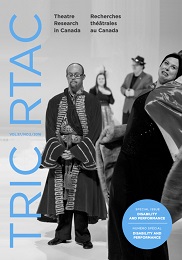Affordance Creations of Disability Performance: Limits of a Disabled Theater
 Along with her colleague, Katherine Zien, postdoc Arseli Dokumaci contributed to the journal Theatre Research in Canada with the article "Affordance Creations of Disability Performance: Limits of a Disabled Theater".
Along with her colleague, Katherine Zien, postdoc Arseli Dokumaci contributed to the journal Theatre Research in Canada with the article "Affordance Creations of Disability Performance: Limits of a Disabled Theater".
The article reflects on the Montreal debut of Disabled Theater, a collaboration between Switzerland’s Theater HORA, a company of actors with cognitive differences, and French choreographer Jérôme Bel. In light of this particular viewing experience, which took place in the presence of a disability studies working group, and taking into account the significant body of writing that has been produced on the piece, the article explores various aspects of Disabled Theater, including audience discomfort, dynamics of staring, ethics of performance, professionalism, repetition and presence, materialism, and agency. Drawing on Arseli Dokumaci’s previous re-theorization of James Gibson’s (1979) notion of affordances, she discusses these aspects in relation to what she terms “affordance-creation.” Moving from the affordances actualized by HORA actors onstage and by a disability studies working group offstage, Arseli Dokumaci argues that disability performance has the potential to transform both theater and the everyday into a venue where normalized ways of undertaking actions are un-made and otherwise unimaginable affordances are brought into life and shared. To this end, she concludes by alluding to Yvonne Schmidt’s (2015) grounded reflections on HORA’s post-Disabled Theater work, and proposes the possibility of considering the event of Disabled Theater as an affordance in itself – one that has opened up new possibilities of theater-making for HORA, and of engaging with disability in critical ways, for Montreal audiences.
The article is to be read alongside Katherine Zien’s contribution to the same issue of Theatre Research in Canada.
Arseli Dokumaci, "Affordance Creations of Disability Performance: Limits of a Disabled Theater" in Theatre Research in Canada, vol. 37, no. 2.
